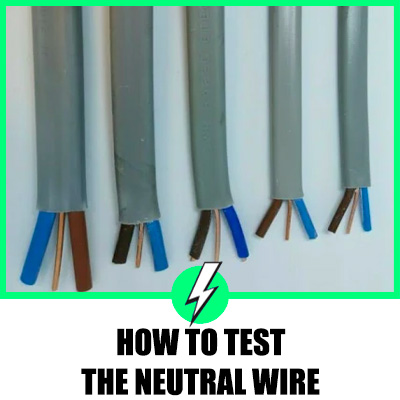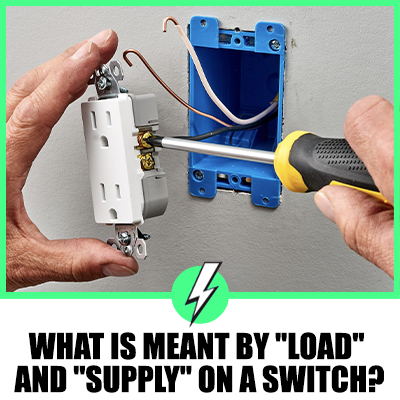How To Test The Neutral Wire
One of the fundamental lessons for aspiring electricians is a thorough understanding of electrical wires. Electrical circuits come with three different types of wires, which have different colours as well. The colour code on the wires usually varies from one country to the other.
Nevertheless, these are the three types of wires in a circuit:

- Live wire: This is the wire that conducts the current from the power supply to the appliance.
- Earth wire: This wire conducts the current to the ground. Also, earth wire prevents the flow of electrical current through a faulty circuit breaker or a fuse. Formally, earth wire was known as the circuit protective conductor or CPC.
- Neutral wire: This wire carries away the current from the appliance back to the power source. The wire completes the circuit.
We are going to break down the different ways to test a neutral wire in this post.
Let’s begin.
Contents
How To Test Neutral Wire
Method 1 – Using the colour-coding chart
Using a colour-coding chart to identify a neutral wire is not testing, per se. But it is the easiest way to identify a neutral wire. The colour-coding of neutral wires is blue. This is the standard code on electrical wires manufactured after 2006.
Pre 2006, the colour code on neutral wires was black. In some cases, you might find that electrical wires from 2004 also have black neutral wires. It is because, although the new colour-coding was in use since 2004, it was not mandatory. But on 1st April 2006, the British Standards Institution made it mandatory to comply with the new colour codes for electrical wiring.
However, relying on colour-coding is not reliable in some cases. So this brings us to the next method to test a neutral wire.
Method 2 – Using a non-contact voltage tester
As the name suggests, this screwdriver like device allows you to test the wires without touching them. These testers are typically powered by a battery and are among the easiest and safest to use. The other name of non-contact voltage testers is inductance testers.
Inductance testers also come with a reddish light towards the tip. This indicator light lights up when it touches a neutral or a live wire.
To test a neutral wire with a tester, you need to contact the tester’s sensing probe to the wire. Suppose the circuit is wired correctly, the neutral wire light up the tester on contact. Besides, some inductance testers also vibrate when it encounters a neutral wire.
This non-contact voltage tester from eOUTIL is a winner in our books. It has a fantastic test range from 60 to 1000V and is safety compliant. The tester also comes with a red indicator light and a buzzer that beeps when the tester detects AC. The LED flashlight near the sensing probe also comes in very handy while using the tester in the dark.
We also loved the high-quality construction of the tester with the ABS material. The pocket clip also makes it very convenient to carry it anywhere you go.
Method 3 – Using a Digital Multimeter
A digital multimeter is a sure-fire way to test whether you have a neutral wire on your hands or not. Using a multimeter might seem complicated in the beginning. On the contrary, it is a straightforward way to test a neutral wire.
A multimeter is very easy on the wallet. If you are not sure which multimeter is right for you, here is one of our favourites. We love its versatility in measuring everything from voltage, current, frequency, resistance, as well as temperature. Furthermore, the LCD makes it effortless to check the readings.
Among the top features of this multimeter are the sturdy construction and provision for hands-free use. The multimeter also comes with a wide range of accessories, including a pouch, which is excellent for portability.
To use a digital multimeter to test a neutral wire, we recommend the following steps:
Set the multimeter to the highest voltage setting in the AC range.
Next, hold the black test lead and connect it to the ground wire. Connecting the probe to a grounded appliance or an object also works.
Now hold the red probe and touch the exposed wires with it. If the wire is live, you will get a reading on the multimeter. However, a neutral wire does not show any reading on the digital multimeter.
Safety tips for testing neutral wire.
Safety is paramount while working with electrical wires. Just because you are testing a neutral wire does not mean you should ignore the safety practices. With that in mind, here are the safety tips for testing neutral wire.
Make sure that your hands are bone dry before you touch a wire. Along the same lines, touching wet wires or appliances and circuits that have been flooded can be dangerous.
Before you start to test a neutral wire, double-check to see that you do not have any metal objects in your pockets.
Standing on wet or bare soil can result in electrocution. So use a dry board or something similar.
Touching or leaning on metal objects is asking for trouble.
Remove such items as fuel accelerants or oxygen from the room or area where you plan to perform electrical repairs.
Always check the power before you test the neutral or any other wire. Simply assuming that the power is off is not a smart move while working with electrical wires or circuits.
Wrapping up
While aspiring electricians must know how to test neutral wire, homeowners and DIYers can also benefit from it. Testing a neutral wire does not require any special skills or specialised equipment. In fact, all you need are essential tools, which are quite affordable too!
However, unless you have some experience handling electrical wires, it’s not advisable to perform electrical repairs. It is best to let an electrician take a good look at the wiring or electrical problem.





